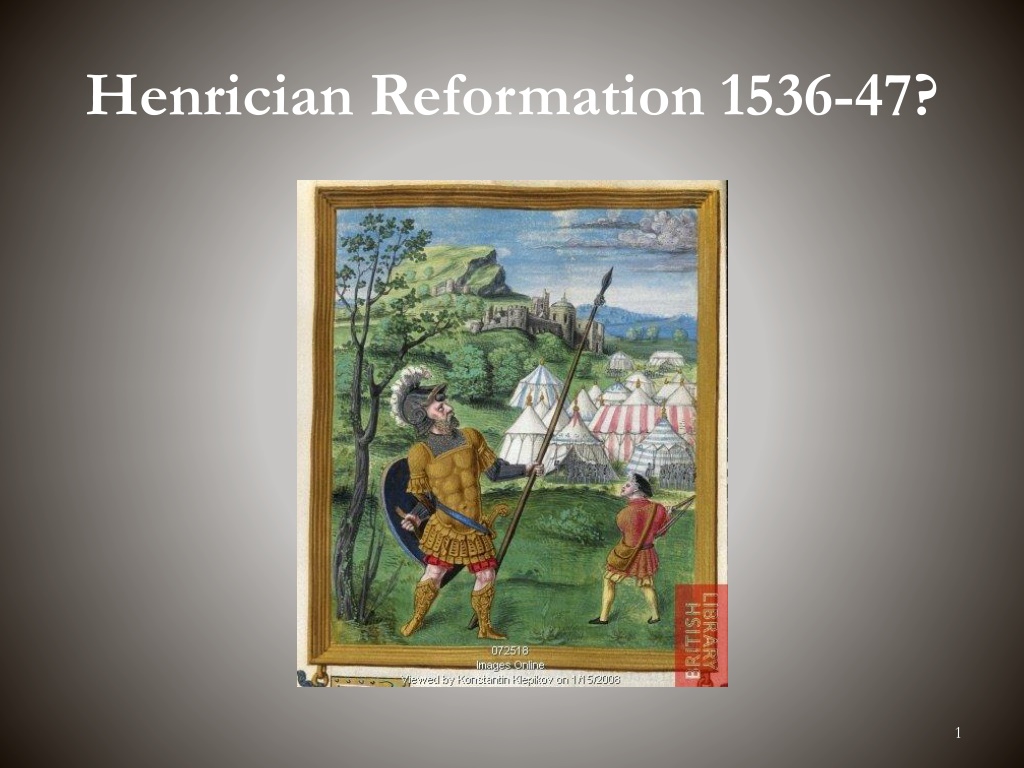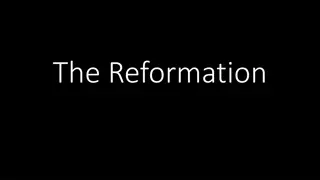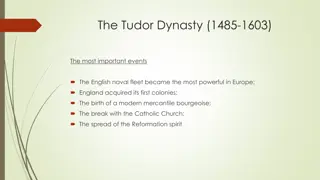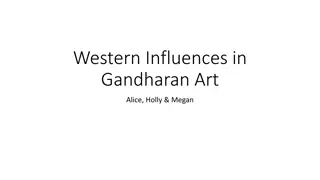Henrician Reformation of 1536-47 - Overview of Key Terms and Influences
The Henrician Reformation of 1536-47 was a period of religious change in England, involving shifts in beliefs, worship practices, and organizational structures. This reform was driven both from above, by rulers imposing changes, and from below, with support from ordinary people. Key terms such as Reformation, Conservative, and Evangelical/Reformer are defined in relation to this historical context, highlighting different perspectives within the religious landscape. Influences on Crown religious policy, key individuals like Thomas Cromwell and Thomas Cranmer, and the Ten Articles of 1536 are also discussed.
Download Presentation

Please find below an Image/Link to download the presentation.
The content on the website is provided AS IS for your information and personal use only. It may not be sold, licensed, or shared on other websites without obtaining consent from the author. Download presentation by click this link. If you encounter any issues during the download, it is possible that the publisher has removed the file from their server.
E N D
Presentation Transcript
Key Terms Reformation: a process of religious change, including changes in doctrine (beliefs and teachings), liturgy (forms of worship) and structure (organisation) Reformation from above: impetus for change originating with the rulers, change imposed by the government on the people with or without their approval Reformation from below: impetus for change originating with ordinary people, i.e. a popular reformation 2
Key Terms Conservative: a supporter of the old religion and of Catholic doctrine. To be conservative was not to be a papalist an advocate of papal supremacy. One could be conservative and a supporter of the royal supremacy, e.g. Duke of Norfolk and Stephen Gardiner 3
Key Terms Evangelical/reformer: not the same as a Protestant. Twin tests of Protestantism were denial of transubstantiation (real presence) and acceptance of justification by faith alone Distinguishing features of an evangelical: 1. Emphasis on faith 2. Support for vernacular Bibles 3. Enthusiasm for preaching 4. Anti-monastic 4
Influences on Crown Crown Religious Policy Opinion at Court Henry VIII s Own Religious Views Episcopacy (Henry s bishops) Key Individuals (e.g. Thomas Cromwell, Thomas Cranmer) Finance Foreign Policy Context Political Considerations 5
Ten Articles (1536) and 1536 Injunctions: Why? Strictly the work of Convocation but authorised by Cromwell as Vicar-General. Part of Cromwell s programme of reform. The Pilgrimage had not yet begun. Injunctions and Ten Articles were issued in August 1536. 6
Bishops Book (1537) Should not be seen as a conservative measure but as a compromise document. The slant was still reformed, e.g. though all seven sacraments were reinstated, three (baptism, communion and penance) were still seen as more important. Minor concessions were a response perhaps to the Pilgrimage of Grace (1536) Henry s own conservative religious outlook. Hybrid document reflected tension between conservative (Stokesley and Tunstall) and evangelical (Cranmer, Latimer and Shaxton) bishops. 7
1538 Injunctions: Why? Rebellion in the North had been contained. Dissolution of the larger houses under way. Resumption of reform programme. Influence of Cranmer. Ascendancy of Cromwell. His evangelical zeal beyond question. He contributed 400 of his own money towards the printing of the Great Bible in English in 1539. He sponsored evnagelical preachers and subsidised reformist printers and translators (Richard Taverner, William Marshall). His own household was a centre of humanist and reformed thinking. 8
1538 (September) Injunctions: Why? June 1538 Treaty of Nice ten year peace between Francis I and Charles V. Invasion threat. Cromwell exploring an alliance with German protestant princes and the Schmalkaldic League. Lutheran embassy arrived in England to agree on a joint confession of faith to underpin a possible alliance 9
Act of Six Articles (1539): Why? Reflection of Henry s own essentially orthodox views. Remember he paid for a thousand masses to be said for Jane Seymour s soul; In his own will he asked for the intercession of the Virgin Mary and the saints, he re- iterated his belief in transubstantiation and left 666 to pay for his soul. Collapse of anti-Imperial alliance with the German protestant princes. Henry had been unwilling to make the doctrinal concessions demanded by the Germans (clerical marriage, communion in both kinds, abolition of Mass) a sign perhaps of Henry s innate religious conservatism. 10
Act of Six Articles (1539): Why? Paul III finally pronounced sentence of excommunication on Henry (December 1538). Entente between papacy, Francis and Charles threatened English national security. A conservative turn in religious policy was necessary to appease the Catholic powers. 11
Act of Six Articles (1539): Why? Fear of heresy. In November 1538 Henry presided over the heresy trial of John Lambert, burned as a sacramentarian (denial of the real presence). In the same month Henry also issued a proclamation against against Anabaptists, sacramentarians and the practice of clerical marriage. 12
Act of Six Articles (1539): Why? Henry feared a process of religious change that he could not control. Anxiety about radicalism and disorder. Anabaptist (communal sharing of property was one of their beliefs) cell uncovered in Calais. Sacramentarians associated with disorder. Affair of the Placards, France, 1534 and breakdown of social order in Munster 1535, where Anabaptists had briefly seized control. The climate of suspicion was evident in the arrest of 190 laymen and 16 priests in 1540 and the burning of three Protestants. 13
Act of Six Articles (1539): Why? Influence of conservatives at court. After three years in France, Gardiner returned to England. Conservatives orchestrated Cromwell s fall in June 1540. Their influence was cemented when the Duke of Norfolk s niece Catherine Howard married the king in July 1540. 14
1539-47: Stasis It is a mistake to see these years as a period of conservative reaction. Rather there were no major doctrinal changes as deadlock prevailed between conservatives and evangelicals and an ageing king, fearful that new ideas and religious change would bring social disorder, remained loyal to his conservative beliefs. 15
Conservative Measures: Kings Book (1543) Restatement of Six Articles. Henry a prime mover. His notes bore the legend not to be [had] out of the privy chamber. Henry VIII penned the King s Book himself. (Guy) In spite of Catherine Howard s execution for adultery in 1542, conservatives remained influential at court. Cranmer isolated. Evangelical bishops, Shaxton and Latimer, had resigned. Episcopacy was conservative Cromwell s execution, July 1540: evangelicals lacked a leader with political clout 16
Conservative Measures: Act for the Advancement of True Religion (1543) Henry had always been wary of vernacular Bibles. They were for reading aloud in church and for exposition in sermons. They were not to be read independently by the laity, however. Access to scripture was for gentlewomen and upper class property-owning males only. There was a danger of divers naughty and erroneous opinions among the lower sort. The penalty for Bible-reading for most laymen was 90 days imprisonment. 17
Conservative Measures: Miscellaneous 1546: burnings of heretics, e.g. Anne Askew on a charge of sacramentarianism Pulpit at St. Paul s Cross in London, the venue of evangelical and radical preaching in the later 1530s, was populated by Catholic preachers In July 1546 a proclamation against heretical books was issued, the first since 1538. Books and Bibles were burned. 18
Reform Measures: Miscellaneous 1544 Litany. Endorsed by Henry, it discouraged the invocation of saints and contained prayers in the vernacular. 1545 Primer a book of religious instruction in English for use in schools. N.B. Neither was a major measure of reform. Reasons: Cranmer s continuing influence and the evangelical outlook of Henry s sixth wife, Catherine Parr, who quietly promoted the reformed cause. 19
Reform Measures: Chantries Act (1545) Act stated that all chantries and their accompanying property would belong to the king for the rest of his reign. No formal dissolution of chantries - a more radical measure that did not occur until 1547 when Edward VI was on the throne. Why? Financial considerations were paramount. The war with France had virtually bankrupted the crown. 20
Was there such a thing as the Henrician Reformation? Yes. The official religion of England amounted to more than Catholicism without the pope . How? 1. monasteries dissolved 2. attack on images and relics, 1536 and 1538 Injunctions 3. introduction of English Bible to every parish 4. burst of evangelical reform (Ten Articles (1536) and Bishops Book (1537) which at least questioned traditional Catholic teaching and spurred theological debate. N.B. 1-3 left unchanged by the conservative reaction of the 1540s. Permanent and irreversible change had occurred which allowed further doctrinal reform. Hence the notion of a Henrician Reformation is valid and not a conceptual sham. 21
Was England a protestant nation by 1547? Not quite the same question as whether or not there was a Henrician reformation. The answer is no. Neither in official doctrine nor popular religious belief was England protestant. The extent of protestantism was limited: 30-40% perhaps in London, 15% in SE, 10% in Midlands outside the towns and almost non-existent in the North. No popular reformation, i.e. from below. 22
Was England a protestant nation by 1547? Parishes were slow to acquire Bibles, though most had them by 1545. Evangelical commitment or fear of fines? Fewer wills made provision for singing of masses for the dead but otherwise, beyond Kent and London, they provide little evidence of popular conversion to protestantism. No more pilgrimages and buying of indulgences or buying of votive candles. But did this indicate changing religious beliefs or unwilling acquiescence in orders from above? 23
Was England a protestant nation by 1547? BUT cells of protestants existed in London and the South East. Elsewhere they were few and far between. e.g. trade in reformed books in London e.g. Bonner (conservative Bishop of London) had investigated heresy in the capital and exposed several hundred sacramentarians. Though protestantism was unpopular, religious divisions were emerging. 24























